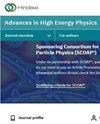Random Statistical Analysis of Transverse Momentum Spectra of Strange Particles and Dependence of Related Parameters on Centrality in High Energy Collisions at the LHC
IF 1.1
4区 物理与天体物理
Q3 PHYSICS, PARTICLES & FIELDS
引用次数: 0
Abstract
We have studied the transverse momentum ( p T ) spectra of the final-state strange particles, including K ± , ϕ , Ξ , and Ω , produced in high energy lead–lead (Pb–Pb), proton–lead ( p –Pb), xenon–xenon (Xe–Xe) collisions at the Large Hadron Collider (LHC). Taking into account the contribution of multiquark composition, whose probability density distribution is described by the modified Tsallis–Pareto-type function; we simulate the p T spectra of the final-state strange particles by a Monte Carlo method, which is shown to be in good agreement with the experimental data in most the cases. The kinetic freeze-out parameters are obtained. The present method provides a new tool for studying the spectra of various particles produced in high energy collisions, reflecting more realistically the collision process, which is of great significance to study the formation and properties of the produced particles.大型强子对撞机高能碰撞中奇异粒子横向动量谱的随机统计分析及相关参数对中心性的依赖
我们研究了在大型强子对撞机(LHC)高能铅-铅(Pb–Pb)、质子-铅(p–Pb)和氙-氙(Xe–Xe)碰撞中产生的最终态奇异粒子的横向动量(PT)谱,包括K±、ξ、ξ和Ω。考虑到多夸克组成的贡献,其概率密度分布由修正的Tsallis–Pareto型函数描述;我们用蒙特卡罗方法模拟了最终态奇异粒子的p-T谱,结果表明,在大多数情况下,该方法与实验数据吻合良好。获得了动力学冻结参数。该方法为研究高能碰撞中产生的各种粒子的光谱提供了一种新的工具,更真实地反映了碰撞过程,对研究产生的粒子的形成和性质具有重要意义。
本文章由计算机程序翻译,如有差异,请以英文原文为准。
求助全文
约1分钟内获得全文
求助全文
来源期刊

Advances in High Energy Physics
PHYSICS, PARTICLES & FIELDS-
CiteScore
3.40
自引率
5.90%
发文量
55
审稿时长
6-12 weeks
期刊介绍:
Advances in High Energy Physics publishes the results of theoretical and experimental research on the nature of, and interaction between, energy and matter. Considering both original research and focussed review articles, the journal welcomes submissions from small research groups and large consortia alike.
 求助内容:
求助内容: 应助结果提醒方式:
应助结果提醒方式:


